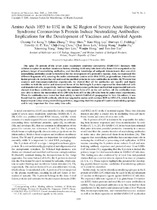| dc.contributor.author | Keng, Choong-Tat | |
| dc.contributor.author | Zhang, Aihua | |
| dc.contributor.author | Shen, Shuo | |
| dc.contributor.author | Lip, Kuo-Ming | |
| dc.contributor.author | Fielding, Burtram C. | |
| dc.contributor.author | Tan, Timothy H.P. | |
| dc.contributor.author | Chou, Chih-Fong | |
| dc.contributor.author | Loh, Chay Boon | |
| dc.contributor.author | Wang, Sifang | |
| dc.contributor.author | Fu, Jianlin | |
| dc.contributor.author | Yang, Xiaoming | |
| dc.contributor.author | Lim, Seng Gee | |
| dc.contributor.author | Hong, Wanjin | |
| dc.contributor.author | Tan, Yee-Joo | |
| dc.date.accessioned | 2013-10-12T20:28:48Z | |
| dc.date.available | 2013-10-12T20:28:48Z | |
| dc.date.issued | 2005 | |
| dc.identifier.citation | Keng, C., et al. (2005). Amino acids 1055 to 1192 in the S2 Region of severe acute respiratory syndrome Coronavirus S Protein induce neutralizing antibodies: Implications for the development of vaccines and antiviral agents, Journal of Virology, 79(6): 3289-3296 | en_US |
| dc.identifier.issn | 0022-538X | |
| dc.identifier.uri | http://hdl.handle.net/10566/748 | |
| dc.description.abstract | The spike (S) protein of the severe acute respiratory syndrome coronavirus (SARS-CoV) interacts with
cellular receptors to mediate membrane fusion, allowing viral entry into host cells; hence it is recognized as the
primary target of neutralizing antibodies, and therefore knowledge of antigenic determinants that can elicit
neutralizing antibodies could be beneficial for the development of a protective vaccine. Here, we expressed five
different fragments of S, covering the entire ectodomain (amino acids 48 to 1192), as glutathione S-transferase
fusion proteins in Escherichia coli and used the purified proteins to raise antibodies in rabbits. By Western blot
analysis and immunoprecipitation experiments, we showed that all the antibodies are specific and highly
sensitive to both the native and denatured forms of the full-length S protein expressed in virus-infected cells
and transfected cells, respectively. Indirect immunofluorescence performed on fixed but unpermeabilized cells
showed that these antibodies can recognize the mature form of S on the cell surface. All the antibodies were
also able to detect the maturation of the 200-kDa form of S to the 210-kDa form by pulse-chase experiments.
When the antibodies were tested for their ability to inhibit SARS-CoV propagation in Vero E6 culture, it was
found that the anti-S 10 antibody, which was targeted to amino acid residues 1029 to 1192 of S, which include
heptad repeat 2, has strong neutralizing activities, suggesting that this region of S carries neutralizing epitopes
and is very important for virus entry into cells. | en_US |
| dc.language.iso | en | en_US |
| dc.publisher | American Society for Microbiology | en_US |
| dc.rights | Copyright American Society for Microbiology. This file may be freely used for educational purposes, as long as it is not altered in any way. Acknowledgement of the authors and the source is required. | |
| dc.source.uri | http://dx.doi.org/10.1128/JVI.79.6.3289-3296.2005 | |
| dc.title | Amino acids 1055 to 1192 in the S2 Region of severe acute respiratory syndrome Coronavirus S Protein induce neutralizing antibodies: Implications for the development of vaccines and antiviral agents | en_US |
| dc.type | Article | en_US |
| dc.privacy.showsubmitter | false | |
| dc.status.ispeerreviewed | true | |
| dc.description.accreditation | Web of Science | en_US |

